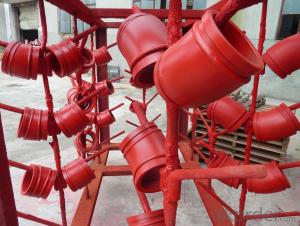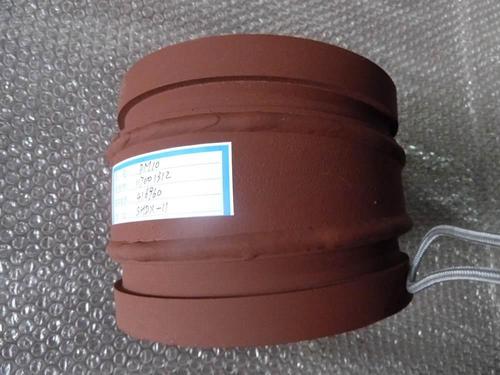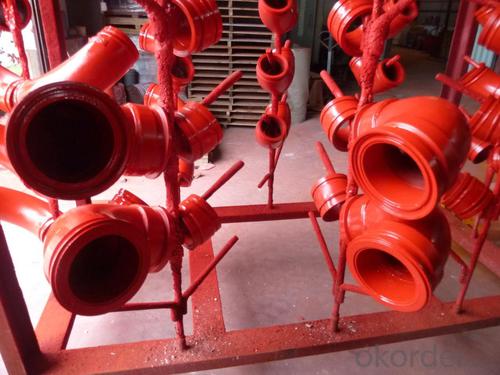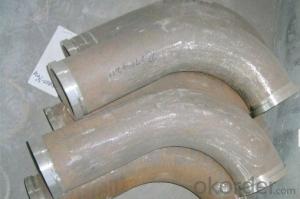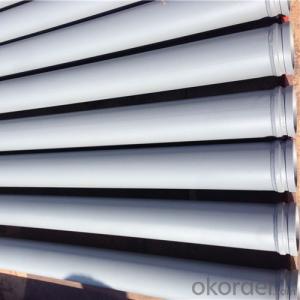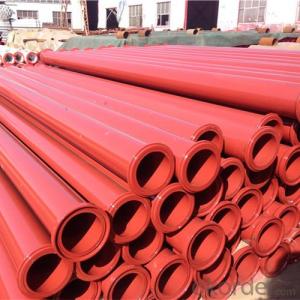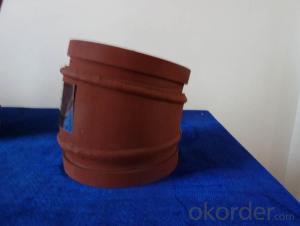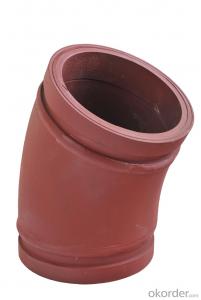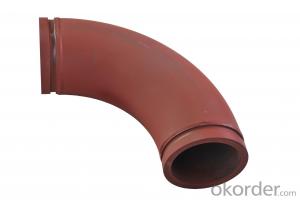Twin Wall Elbow for Concrete Pump R275 10DGR
- Loading Port:
- Tianjin
- Payment Terms:
- TT or LC
- Min Order Qty:
- 20 pc
- Supply Capability:
- 5000 pc/month
OKorder Service Pledge
OKorder Financial Service
You Might Also Like
Product Description:
Product Name: Twin Wall Elbow (Twin Wall Flange)
1. Specification
(1) Material: Q235 (outside) + GCr15(inside)
(2) Thickness: 3mm (outside) + 9mm (inside)
(3) Technology: Quenching under high temperature
(4) Characteristics: the inner rigidity to 63 HRC; the outside has so high toughness to keep the inner.
(5) Matched with: Twin wall flange, Alloy (GCr15) + 20#
(6) Working Pressure:170bar
(7) Service life: above 60,000 cubic meters.
(8) Package: PP woven bag and plastic cap
2. Application
Concrete mixing and delivery.
3. Package
Put into containers.
FAQ:
Q1: Why buy Materials & Equipment from OKorder.com?
A1: All products have its ISO certifications, adheres to the highest standards and a commitment to supply chain safety and customer satisfaction.
Q2: How do we guarantee the quality of our products?
A2: We have established an advanced quality management system which conducts strict quality tests at every step, from raw materials to the final product. At the same time, we provide extensive follow-up service assurances as required.
Q3: How soon can we receive the product after purchase?
A3: Within three days of placing an order, we will begin production. The specific shipping date is dependent upon international and government factors, but is typically 10 to 30 workdays.
Q4: If we can produce Twin Wall Elbow (Twin Wall Flange) according to customers request?
A4: Yes, we can produce Twin Wall Elbow (Twin Wall Flange) according to the difference country situations to make it suitable to the market and customers. We have very professional technical team to make the design.
Q5: How to make a quick resolution for after service?
A5: We have overseas branches all-around of world, If needed, the seller shall dispatch 2 engineers to the buyer's site for supervision of training. The buyer shall make available of necessary facilities &skilled personnel at site for training.
Images:
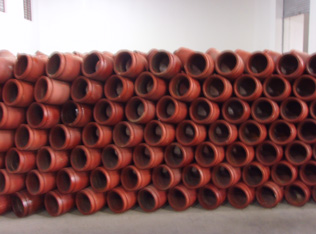

- Q: How does a hydraulic accumulator improve the performance of a concrete pump?
- A hydraulic accumulator improves the performance of a concrete pump by storing excess hydraulic pressure and energy during low-demand periods and releasing it when needed. This allows for a smoother operation, reduced pump pulsation, and improved efficiency in delivering the concrete, resulting in enhanced performance and productivity.
- Q: Are there any specific guidelines for the installation of wear plates or cutting rings in concrete pump spare parts?
- Specific guidelines exist for the installation of wear plates and cutting rings in concrete pump spare parts, as they are crucial for the proper functioning and longevity of the pump. To begin, it is important to thoroughly clean the surface where the wear plate and cutting ring will be installed, removing any debris, dust, or old material to ensure a smooth and secure fit. Before installation, it is necessary to inspect the wear plate and cutting ring for any damage or defects. Any worn-out or damaged parts should be replaced to prevent any potential issues during operation. To aid in alignment and ease of installation, a thin layer of lubricant or grease should be applied to the surface where the wear plate and cutting ring will be installed. The wear plate and cutting ring should then be carefully aligned with the designated slots or grooves in the concrete pump. Accurate positioning is crucial to avoid misalignment or premature wear. Appropriate tools or equipment should be used to secure the wear plate and cutting ring in place, such as tightening bolts, screws, or other fasteners. It is essential to follow the manufacturer's instructions and torque specifications for proper installation. After installation, a visual inspection should be performed to ensure that the wear plate and cutting ring are securely in place and correctly aligned. Any signs of misalignment or loose parts should be addressed immediately. Regular maintenance and inspection of the wear plates and cutting rings are essential to identify any signs of wear or damage. It is advisable to follow the manufacturer's recommendations for maintenance intervals and replacement schedules. By adhering to these specific guidelines, the proper installation and function of wear plates and cutting rings in concrete pump spare parts can be ensured, resulting in improved performance and an extended lifespan for the equipment.
- Q: What is the role of a concrete pump spectacle plate?
- The role of a concrete pump spectacle plate is to provide support and stability to the concrete pump's boom. It acts as a mounting base for the pipeline, allowing the pump to accurately and efficiently deliver concrete to the desired location.
- Q: Are there any environmental considerations in the production of concrete pump spare parts?
- Concrete pump spare parts have several environmental considerations. Firstly, the production process involves the use of various materials and chemicals that can harm the environment. For instance, steel components require the extraction of iron ore and emit greenhouse gases during smelting. Similarly, rubber parts use petroleum-based materials, which contribute to carbon emissions and pollution. Additionally, the disposal of these spare parts after their useful life can create environmental challenges. If not managed properly, they can end up in landfills, leading to waste accumulation and potential soil and water contamination. Hence, it is crucial to consider the recyclability and reusability of these parts during their design and production. To address these concerns, manufacturers can adopt sustainable practices. This includes incorporating recycled materials like steel or rubber into the manufacturing process. Moreover, efficient production techniques can reduce waste generation and energy consumption. Establishing proper waste management and recycling programs is also vital for responsible disposal of these spare parts. Overall, by considering the environmental impacts associated with the production and disposal of concrete pump spare parts, manufacturers can contribute to a more sustainable and eco-friendly industry.
- Q: How do I maintain and clean concrete pump spare parts?
- Maintaining and cleaning concrete pump spare parts involves regular inspections, lubrication, and following proper cleaning procedures. Firstly, conduct routine checks to identify any signs of wear, damage, or loose connections. Lubricate the moving parts as recommended by the manufacturer to ensure smooth operation and prevent rust. When cleaning, use a mild detergent and water solution to remove any dirt, debris, or concrete residue. Avoid using harsh chemicals or abrasive tools that could damage the parts. It's crucial to follow the manufacturer's guidelines and consult the equipment manual for specific instructions on maintaining and cleaning concrete pump spare parts.
- Q: How often should concrete pump clamps be inspected and replaced?
- Concrete pump clamps should be inspected on a regular basis to ensure they are functioning properly and to identify any signs of wear or damage. The frequency of inspections will depend on various factors such as the frequency of use, the type of concrete being pumped, and the working conditions. In general, it is recommended to inspect concrete pump clamps at least once a month or after every 100 hours of operation, whichever comes first. This will help catch any potential issues early on and prevent them from escalating into major problems. Additionally, it is important to visually inspect the clamps before each use to check for any visible signs of damage or wear. This includes checking for cracks, deformations, or any loose or missing bolts. The lifespan of concrete pump clamps will vary depending on the quality of the clamps, the intensity of use, and the maintenance practices. However, as a general guideline, it is recommended to replace the clamps every 1-2 years or sooner if they show significant signs of wear or damage. Regular inspections and timely replacements of concrete pump clamps are vital to ensure the safety and efficiency of the pumping operations. It is always better to be proactive and address any potential issues promptly to prevent costly repairs or accidents.
- Q: Can concrete pump spare parts be customized according to specific requirements?
- Yes, concrete pump spare parts can be customized according to specific requirements. Customization allows for the adaptation of parts to meet specific needs such as size, shape, material, or functionality. This enables better compatibility and enhances the efficiency and performance of concrete pumps.
- Q: Can I get spare parts for concrete pump wear plates and cutting rings?
- Yes, you can definitely get spare parts for concrete pump wear plates and cutting rings. These parts are essential for the smooth operation and performance of a concrete pump. Many manufacturers and suppliers specialize in providing spare parts for concrete pumps, including wear plates and cutting rings. You can contact these suppliers or manufacturers directly to inquire about the availability and pricing of these spare parts. Additionally, there are also online platforms and marketplaces where you can find a wide range of spare parts for various concrete pump models. It is always recommended to ensure that you purchase genuine and high-quality spare parts to guarantee the longevity and efficiency of your concrete pump.
- Q: How can one identify the need for replacement of concrete pump spare parts?
- The need for replacement of concrete pump spare parts can be determined by observing specific signs and conducting regular maintenance checks. To begin with, it is crucial to keep track of the concrete pump's performance. If there is a decrease in efficiency or a noticeable reduction in output, it could indicate the requirement for replacement parts. This could be a result of worn-out components that are impacting the pump's ability to deliver concrete effectively. Another indication to be mindful of is any unusual noise emanating from the pump. Excessive or abnormal noise can be a sign of problems with the moving parts, such as bearings or seals, which may need to be substituted. It is also essential to inspect the wear and tear of the spare parts. Components like hoses, pipes, and seals can deteriorate over time due to the abrasive nature of concrete. If there are observable signs of wear, such as cracks, leaks, or bulges, it is likely that these parts need to be replaced. Conducting regular maintenance checks is critical in identifying the need for replacement parts. This involves examining the condition of key components, such as the piston, cylinder, and valves, and ensuring that they are clean, properly lubricated, and functioning correctly. Any signs of damage, corrosion, or excessive wear should be promptly addressed to prevent further harm to the pump and the need for more extensive repairs. In conclusion, by closely monitoring the concrete pump's performance, listening for abnormal noise, inspecting for wear and tear, and regularly conducting maintenance checks, one can effectively determine the need for replacement of concrete pump spare parts. Timely replacement of these parts can contribute to maintaining the pump's efficiency and prolonging its lifespan.
- Q: Can concrete pump spare parts be tested for compatibility with different types of concrete mixes?
- Testing for compatibility with different types of concrete mixes is crucial for concrete pump spare parts. These spare parts, including pipes, hoses, and valves, are specifically designed to handle distinct pressures, flow rates, and concrete mix types. To determine compatibility, the spare parts undergo testing with various concrete mix compositions, which encompass diverse aggregate sizes, cement types, and admixtures. This testing procedure assesses the spare parts' ability to withstand the unique characteristics and properties of different concrete mixes. The compatibility testing process evaluates factors such as durability, resistance to abrasion and corrosion, and the capacity to meet specific pumping requirements for various concrete mixes. This testing can be carried out either in laboratory settings or on-site, depending on the project's specific needs. By conducting compatibility testing on concrete pump spare parts, potential issues like clogging, wear and tear, or reduced performance can be identified and resolved in advance. This ensures smoother and more efficient concrete pumping operations, reducing downtime and enhancing overall productivity. It is important to note that manufacturers of concrete pump spare parts often provide technical specifications and guidelines for their products, including information on compatibility with different concrete mix types. Adhering to these guidelines and performing compatibility testing aids in achieving optimal performance and longevity of the spare parts, resulting in successful concrete pumping operations.
Send your message to us
Twin Wall Elbow for Concrete Pump R275 10DGR
- Loading Port:
- Tianjin
- Payment Terms:
- TT or LC
- Min Order Qty:
- 20 pc
- Supply Capability:
- 5000 pc/month
OKorder Service Pledge
OKorder Financial Service
Similar products
Hot products
Hot Searches
Related keywords


